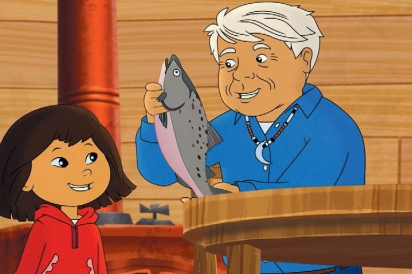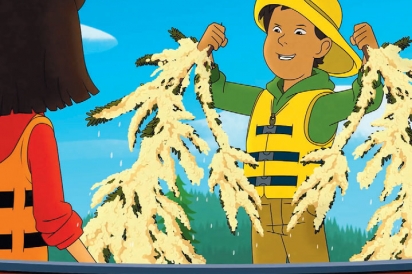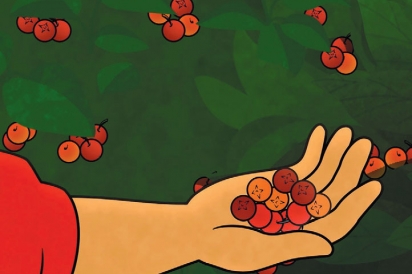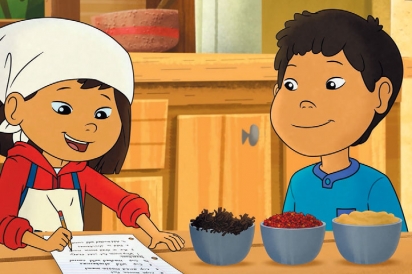Delicious Representation
Layla Mabray is cutting up maqtaq (whale blubber) with an ulu as her energetic daughter Molly tries to convince her to travel to Sitka to harvest herring eggs. As part of her argument for the worthiness of the trip, Molly exclaims, “But herring eggs are my favorite food!”
As an Alaska Native woman, watching this animated scene unfold on PBS KIDS—a national platform— knowing millions of children were watching was nothing short of inspiring. I got unexpectedly emotional as this little unstoppable “Molly of Denali” excitedly ate foods I had certainly never seen animated before. What’s more, I didn’t know how important it was to see them on screen until I actually saw them on screen.
Before Molly of Denali, the only time I’d seen foods of my culture portrayed in a national broadcast was on the popular Travel Channel show that aired for 23 seasons, Bizarre Foods with Andrew Zimmern. As the name suggests, they were not featuring Alaska Native dishes because this arbitrary judge of foods thought they were delicious. In the description for the Alaska episode, the lead-in proclaims the brave host will take a bite of everything he’s given, “regardless of how it smells.” How disheartening it was to see him in the homelands of our people, talking about how weird our food was. I couldn’t watch the whole episode.
Growing up eating herring eggs and beach greens and dried black seaweed, I was used to a fair amount of “What is THAT?” if I ever talked about it or ate it in front of non- Natives. In a dominant culture weighted with chicken nugget dreams and Lunchables ads, I felt from a very early age that the food that made me feel most connected to my people and my land was… weird. It was unusual, and not in a desirable way. And therefore, there was something about me that was a little weird, and a little undesirable.
And then there was Molly.
I was fortunate enough to be present at the inception of the herring egg episode. I am a writer for the series, and the first writer’s room for the show was in the winter of 2017. I was excited to hear ideas the other writers were going to pitch. I honestly did not expect much of real Alaska life to make its way into these first pitches, as the other series writers were not from Alaska and were not Native (there would be an Alaska Native writing fellowship formed the next year). Alaska has not had many realistic portrayals in pop culture, and so I was ready to hear some stereotypical portrayals of Alaska.
Wow, was I wrong! In that first writer’s meeting, the group touched on forced boarding schools for Native people, traditional names, and drumming. The group had a crash course in Alaska Native culture the previous two days and brought the magic. But it was when one of the writers, Peter Ferland, brought up the ideas of herring eggs that I believe my jaw dropped.
Herring eggs ARE my favorite! And I said so.
To hear we could portray herring eggs to the world in an animated series was still not something I totally believed would really happen. Herring eggs and maqtaq (sometimes spelled maktak or muktuk) are not commonly known in the U.S. outside of Alaska, but are incredibly beloved foods of Alaska Native people. For that matter, many Alaska Native foods are not well known to the wider public.
Princess Daazhraii Johnson (Neets’aii Gwich’in) is an artist and activist with a great love of the Alaskan foods the land gives to us. She’s also a producer of Molly of Denali. But while she was challenged growing up on her love of indigenous foods, her son is having quite a different experience:
My son, K’edzaaye’, loves our Alaska Native foods so much. When we process salmon in the summer and see a sac of fresh salmon eggs, he immediately asks, “Mom, can I have some fish eggs?” He’s also a big fan of fisheyes! Like Molly, maktak is one his favorites.
Once while eating some, he came up to me and my Inupiaq friend and said quite earnestly, “Mom, I think I’m part ocean.” For my son to so beautifully put to words the feeling that our Native foods give us was a profound moment. My friend and I looked at each other, taking in what he said.
“Yes, you are,” I responded.
When I was his age, I would have been too shy to be so open about my love of Native foods for fear someone might shame me. By his age, I had heard all sorts of negative things uttered by my classmates and others about us as Alaska Native people and the foods we ate. My son, though, who can also be shy, isn’t growing up with that stigma. He has a large extended family and community who continuously show pride in our Gwich’in and Koyukon cultures.
I hope that the way Molly loves her Native foods inspires our children to see it’s a beautiful thing to honor our deep connection to our Native foods and underscores the value of respect for all living things and taking only what you need.
—Princess Daazhraii Johnson, Molly of Denali Creative Producer
As much as the food is important to see on Molly, I also love to see how the values around the land and the gathering of food are portrayed. All Alaska Native cultures have core values that you must show gratitude to the land and creatures that enable you to live. While each culture handles these feelings and shows of gratitude in different ways, the basic idea is that you find a way to say, “Thank you.”
Molly and her village frequently display this gratitude in small, familiar ways. In my episode of “New Nivagi,” when Molly picks some berries to complete her dish, she says, “Baasee’ berries!” before leaving— or “thank you” to the berries in Koyukon. In the episode “Have Canoe, Will Paddle,” the character of Mr. Patuk offers thanks to the river. Extending that gratitude toward those who show us how to live on this land, in “First Fish,” Molly completes a tradition that spans cultures of gifting the first of what you’ve caught or hunted, in this case a fish, to an Elder. Molly gifts her first fish to her grandfather.
I can’t remember this attitude toward food or where we get it being portrayed in any show I’ve seen, much less a children’s show. It is such a central part of the culture I was raised in, and the values I was taught as a child, but it never seemed any other children were being taught this— or wouldn’t I have seen it?
In February, Filipino-American Professor E.J. Ramos David was driving along one day when his 10-year-old Athabascan and Filipino son asked him if he ate balut, a Filipino dish, and then started talking about maqtaq. David discovered his son was reading from a book about “disgusting foods,” and they described in great detail just why these dishes were “disgusting.”
“This book is explicitly telling my Filibascan kids that their cultures are ‘disgusting,’” he wrote on Twitter. “It’s 2020 and the books in our schools are still teaching our kids to be racist.”
In this case, the story has a fairly happy ending. The publisher of the book, Capstone Publishing, quickly picked up on the Twitter thread.
“We are mortified and ashamed,” Capstone posted the next day. “You are right to call this book out as racist and we are taking steps today to remove it from active sale.”
While this incident ended on a fairly satisfactory note, it is also a showcase of just how easily the “cultural” or “ethnic” foods we were raised with can become one more way of saying, “You’re not like us. And that’s bad.” The power of the dominant culture is that we even internalize these attitudes. We are taught from infancy that we’re not good enough. Foods can be an even more powerful symbol of cultural “inadequacy” because they are, at the same time, an everyday, repetitive reminder of how we differ, and a powerful connection to our culture.
Perhaps this is why I dove into Alaska Native foods for my first episode. In “New Nivagi,” Molly makes a dish called nivagi, though it is better known in Alaska as agutak (nivagi is the Dena’ina word for the dish). Agutak is generally made with whipped animal fat like moose, caribou, or seal, berries, and a finely shredded meat or fish.
Sometime during the writing of my fifthepisode, as I inserted a comment about blueberry lemonade, I realized all of my episodes had some comment, running joke, or highlight about food. Only my first episode was actually about an Alaska Native dish, but it seemed I couldn’t write about a little Alaska Native girl without at least mentioning food.
As an adult, I can see how special our foods are, and how precious our connections to the land and our ancestors are through our foods. And yet I still want to apologize for the smell of herring eggs if I cook it—a smell that makes my mouth water with anticipation. I still want to explain why eating whipped fat and berries isn’t that different from “normal” food. I still feel a need to justify and validate foods my ancestors have been eating for millennia on this land.
So it’s quite powerful to see this little Alaska Native girl being raised in a village that not only eats our foods, but also celebrates them. How important to see her jumping up and down because she gets to eat herring eggs, or assuming her grandfather will want an enormous amount of dry fish on his trip, or being so proud to make nivagi.
Just as negative portrayals of our cultural foods, or the lack of portrayal, can ingrain themselves in children’s ideas of how valued that person or their culture is, the positive portrayal and exposure to these foods can speak to just how wonderful being an Alaska Native child can be. Better representation of cultural food can teach children that people who are different are worth knowing. Instead of seeing someone unlike them as weird or less-than, representation can make children want to learn more.
I have been told of, or heard about, several children who wanted to make nivagi after viewing the episode, and it makes my day every time. But just a week ago, I heard that a young Molly of Denali fan named Ruby, who is not Native, was fascinated with the idea of herring eggs, and wanted to try them. I can’t tell you how that thrilled me. I had never heard of any non-Native child requesting to eat herring eggs. And of course I was going to find her some!
The funny thing was, when the girl and her family came to pick up some frozen herring eggs, I still couldn’t stop my apologies and warnings. I said they’re an acquired taste, so not to feel bad if she doesn’t like them. And even after we took photos and I had explained how to cook them, I felt the need to take more time and justify why I thought they were delicious, even if she might not. A lifetime of feeling like the foods I loved were weird made me keep Ruby and her mom captured in my entryway longer and longer.
Finally, Ruby tugged her mom’s coat.
“Mom,” she said in the kind of loud whisper only a young child can accomplish. “Can we go eat the herring eggs now?”
What a funny and important reminder that all my insecurities and justifications about loving this food didn’t matter to this child. All she knew about herring eggs was that Molly Mabray loved them. And that was good enough for her.
Edible Alaska is pleased to publish this story in partnership with First Alaskans Magazine.









